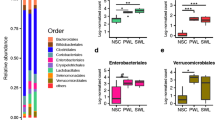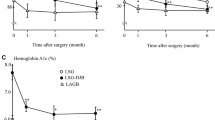Abstract
Introduction
Some traditional bariatric surgery procedures may lead to functional gut shortening, which may unsettle the fine-tuned gastrointestinal physiology and affect gut microbiota balance.
Purpose
Evaluate the gut microbiota behavior in rat models facing gut shortening due to intestinal bypass.
Materials and Methods
Wistar rats (n = 17) were randomly distributed in three groups: (1) sham group (n = 5); (2) blind loop group (n = 6); and (3) resection group (n = 6). Intestinal samples and feces were analyzed to measure bacterial concentrations (small intestinal bacterial overgrowth—SIBO) 12 weeks after the experimental procedures. Bacterial translocation (BT) was investigated in the mesenteric lymph node (MLN), liver, spleen, and lung of the animals. In addition, inflammatory aspects were investigated in their liver and small bowel through histological analysis.
Results
Regardless of blind loop, gut shortening groups recorded similar high level of bacterial concentrations in intestine compartments, greater than that of the sham group (p ≤ 0.05). BT was only observed in the MLN of gut shortening models, with higher percentage in the blind loop group (p ≤ 0.05). The gut and liver histopathological analysis showed similar low-grade chronic inflammation in both gut shortening groups, likely associated with SIBO/BT events.
Conclusion
Sustained SIBO/BT was associated with proximal gut shortening in half regardless of blind loop, whereas the GI tract’s ability to restore gut microbiota balance after a surgical challenge on the small bowel appears to be linked to the functional remaining gut.






Similar content being viewed by others
References
The GBD 2015 Obesity Collaborators. Health effects of overweight and obesity in 195 countries over 25 years. N Engl J Med. 2017;377(1):13–27.
Angrisani L, Santonicola A, Iovino P, et al. IFSO worldwide survey 2016: primary, endoluminal, and revisional procedures. Obes Surg. 2018. [Epub ahead of print].
Schauer PR, Bhatt DL, Kirwan JP, et al. Bariatric surgery versus intensive medical therapy for diabetes — 5-year outcomes. N Engl J Med. 2017;376(7):641–51.
English WJ, DeMaria EJ, Brethauer SA, et al. American Society for Metabolic and Bariatric Surgery estimation of metabolic and bariatric procedures performed in the United States in 2016. Surg Obes Relat Dis. 2018;14(3):259–63.
Ramos AC, Silva AC, Ramos MG, et al. Simplified gastric bypass: 13 years of experience and 12,000 patients operated. Arq Bras Cir Dig. 2014;27(Suppl 1):2–8.
Griffen Jr WO, Young VL, Stevenson CC. A prospective comparison of gastric and jejunoileal bypass procedures for morbid obesity. Ann Surg. 1977;186(4):500–9.
Nora M, Morais T, Almeida R, et al. Should Roux-en-Y gastric bypass biliopancreatic limb length be tailored to achieve improved diabetes outcomes? Medicine (Baltimore). 2017;96(48):1–7.
Murad AJ, Cohen RV, de Godoy EP, et al. A prospective single-arm trial of modified long biliopancreatic and short alimentary limbs roux-En-Y gastric bypass in type 2 diabetes patients with mild obesity. Obes Surg. 2018;28(3):599–605.
Liou AP, Paziuk M, Luevano Jr JM, et al. Conserved shifts in the gut microbiota due to gastric bypass reduce host weight and adiposity. Sci Transl Med. 2013;5:178ra141.
Kong LC, Tap J, Aron-Wisnewsky J, et al. Gut microbiota after gastric bypass in human obesity: increased richness and associations of bacterial genera with adipose tissue genes. Am Soc Nutr. 2013;98:16–24.
Osto M, Abegg K, Bueter M, et al. Roux-en-Y gastric bypass surgery in rats alters gut microbiota profile along the intestine. Physiol Behav. 2013;119:92–6.
Tremaroli V, Karlsson F, Werling M, et al. Roux-en-Y gastric bypass and vertical banded gastroplasty induce long-term changes on the human gut microbiome contributing to fat mass regulation. Cell Metab. 2015;22:228–38.
Palleja A, Kashani A, Allin KH, et al. Roux-en-Y gastric bypass surgery of morbidly obese patients induces swift and persistent changes of the individual gut microbiota. Genome Med. 2016;8(1):67.
Lee YK, Mazmanian SK. Has the microbiota played a critical role in the evolution of the adaptive immune system? Science. 2010;330(6012):1768–73.
Cho I, Blaser MJ. The human microbiome: at the interface of health and disease. Nat Rev Genet. 2012;13(4):260–70.
Clemente JC, Ursell LK, Parfrey LW, et al. The impact of the gut microbiota on human health: an integrative view. Cell. 2012;148(6):1258–70.
Bures J. Small intestinal bacterial overgrowth syndrome. World J Gastroenterol. 2010;16(24):2978–90.
Koh IHJ, Montero E, Guatelli R, et al. Comparative study of bacterial translocation in small bowel and colon in rats. Rev Col Bras Cir. 1995;22:30–2.
Koh IHJ, Montero EF, Keller R, et al. Bacterial concentration versus bacterial translocation. An experimental study in rats. Rev Col Bras Cir. 1995;22:38–9.
Xue H, Song D, Shi B, et al. Tracking of green fluorescent protein labeled Escherichia coli confirms bacterial translocation in blind loop rat. J Surg Res. 2007;143(2):206–10.
Viddal K. Intestinal bypass. A randomized, prospective clinical study of end-to-side and end-to-end jejunoileal bypass. Scand J Gastroenterol. 1983;18(5):627–34.
Rosina M, Micheletto G, Vita PM, et al. Intestinal jejunoileal microflora bypass settlement for morbid in patients obesity with. Obes Surg. 1993;3:239–45.
Kostic AD, Xavier RJ, Gevers D. The microbiome in inflammatory bowel disease: current status and the future ahead. Gastroenterology. 2014;146(6):1489–99.
Sabaté JM, Jouët P, Harnois F, et al. High prevalence of small intestinal bacterial overgrowth in patients with morbid obesity: a contributor to severe hepatic steatosis. Obes Surg. 2008;18(4):371–7.
De Minicis S, Rychlicki C, Agostinelli L, et al. Dysbiosis contributes to fibrogenesis in the course of chronic liver injury in mice. Hepatology. 2014;59(5):1738–49.
Cani PD, Neyrinck AM, Fava F, et al. Selective increases of bifidobacteria in gut microflora improve high-fat-diet-induced diabetes in mice through a mechanism associated with endotoxaemia. Diabetologia. 2007;50(11):2374–83.
Qin J, Li Y, Cai Z, et al. A metagenome-wide association study of gut microbiota in type 2 diabetes. Nature. 2012;490(7418):55–60.
Ley R, Turnbaugh P, Klein S, et al. Microbial ecology: human gut microbes associated with obesity. Nature. 2006;444(7122):1022–3.
Tilg H. Obesity, metabolic syndrome, and microbiota multiple interactions. J Clin Gastroenterol. 2010;44:16–8.
Author information
Authors and Affiliations
Corresponding author
Ethics declarations
Conflict of Interest
The authors declare that they have no conflict of interest.
Ethical Approval
All applicable institutional and national guidelines for the care and use of animals were followed. The present study was previously approved by Local Ethics Committee (UNIFESP – 0215/11).
Informed Consent
Does not apply.
Rights and permissions
About this article
Cite this article
Bastos, E.L.S., Liberatore, A.M.A., Tedesco, R.C. et al. Gut Microbiota Imbalance Can Be Associated with Non-malabsorptive Small Bowel Shortening Regardless of Blind Loop. OBES SURG 29, 369–375 (2019). https://doi.org/10.1007/s11695-018-3540-1
Published:
Issue Date:
DOI: https://doi.org/10.1007/s11695-018-3540-1




